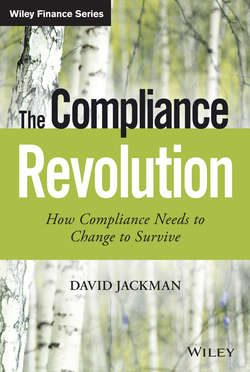Читать книгу The Compliance Revolution - Jackman David - Страница 5
На сайте Литреса книга снята с продажи.
Preface
ОглавлениеThis book is about maturity —corporate maturity– how businesses grow up and become more reasoned and responsible, and also more effective and better performing. It is also about the maturing of compliance into a profession, a critical function that sits at the interface between business and wider society. The quest is relevant to all forms of business and to many functions and the models presented here have general applicability.
What maturity is and how to grow is subtle and complex. We contend that however you define or try to create maturity, it is recognizable to customers, employees, and investors – and to regulators, who are increasingly concerned with corporate culture, integrity, governance, and conduct risk.
We use as our example financial services, a sector whose responsibility has been much challenged of late and where regulatory approaches and compliance practices are changing apace. Financial services also impacts many other areas of business that are dependent on its role while, as we have seen since the 2008 global financial crisis, its influence spreads out into the wider economy of Main Street and influences the opportunities and prosperity of many across our communities. Compliance has a key position, mediating between the powerful drivers in a highly competitive, complex, and internationalizing industry and the needs of the encircling realm of its multiple stakeholders. We will consider how compliance can use its pivotal role in strategically directing companies towards a more mature and responsible culture. In doing so, the function also transforms itself and demonstrates considerable value.
The rate of change in regulation and compliance has hastened in recent years, partly reflecting the rapid development within the financial services industry and partly because of an internal momentum within regulation that seeks new methodologies and procedures in pursuit of the long-term goal of greater effectiveness and efficiency. This internal momentum generates layer-upon-layer of regulatory reform and consequent compliance evolution, but the processes underlying change have reached such a pitch that recent stages can only be described as requiring a “compliance revolution.” This revolution is just starting, and the most significant steps are still to come.
However, few in compliance, regulation, or senior management are aware of this revolution, its implications for the wider business, and how compliance needs to prepare and lead. A primary purpose of this book is to make compliance practitioners aware of this revolution, how to manage change, and what is required of them. If compliance fails to step up, it is likely that the function will lose influence and become marginalized. The opportunity for professionalizing may not return.
Part of the armory of any profession is a clear model and narrative of how it adds value to businesses and the wider economy. This is absent for compliance, which has been historically reactive, subject to fashion, and somewhat cyclical. Here we attempt to fulfill the urgent need for an overall development model for compliance and regulation. We also add a new suite of technologies and methodologies that give more meat to its practices and buttress a claim for professionalism.
The book comprises three parts:
Part I: Theory – a model of regulatory and compliance development
Part II: Practice – tools and techniques to improve compliance performance
Part III: Purpose – the overall aims and drivers of new compliance
Compliance is at a fork in the road. If compliance steps up its value, its status will be enhanced; miss the opportunity, and other functions may well appropriate traditional territory. This book aims to help compliance, regulators, and businesses make wiser, more mature choices.
David Jackman
Easedale
2015
